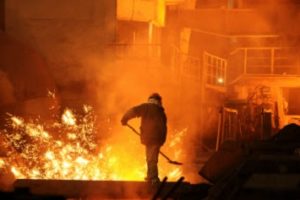The California Occupational Safety and Health Administration (Cal/OSHA) has had a heat illness prevention rule in place since 2006; that rule has been revised and updated several times. But, as often as it has been updated and as determinedly as Cal/OSHA has enforced it, the rule has had one huge, gaping hole in coverage: indoor workers.

sdlgzps / Vetta / Getty Images
After a few failed attempts to put an indoor heat illness prevention rule in place, the California legislature stepped in. In September 2016, Governor Jerry Brown signed S.B.1167, Employment safety: indoor workers: heat regulations into law. The law required Cal/OSHA to propose a standard that minimizes heat-related illness and injury among workers working in indoor places of employment by January 1, 2019. Working well ahead of schedule, Cal/OSHA published a “discussion draft” of the rule and held an advisory meeting about it on February 28, 2017.
What’s in the Proposal
How closely the “discussion draft” will resemble the final standard remains to be seen, but at this time Cal/OSHA’s proposal covers:
- Indoor workplaces hotter than 80 degrees Fahrenheit (°F). For workers doing heavy physical labor, the heat illness provisions are proposed to take effect at 80°F; for all other workplaces, the rule would go into effect at temperatures at or above 90°F. Workplaces that are ordinarily air conditioned are exempt, even when the air conditioning is temporarily not working, unless the temperature goes over 90°F. There is another exception for exposures lasting less than 1 hour per day. Unlike the outdoor standard, the indoor standard requires employers to account for both radiant heat and the workers’ clothing as factors affecting exposure.
- Heat illness prevention plans. Like the outdoor heat illness prevention standard, this one requires covered employers to create a written heat illness prevention plan that details how each of the standard’s requirements will be met. The requirements are more extensive than those in the existing outdoor standard.
- Hazard identification. Heat stress hazards should be assessed when temperatures are at or near the annual high and should be reassessed if conditions change in a way that could affect the original assessment. The assessment should include measurement of the wet bulb globe temperature (WBGT), an estimate of the length of workers’ exposure, and employees’ work activity levels, and clothing-adjustment factors.
- Rest and hydration. Employers must provide potable drinking that is (at a minimum) fresh, pure, suitably cool, provided free of charge, and located conveniently to the work area. Workers should be encouraged to take cool-down rests as needed, and any worker who takes a cool-down rest should be carefully monitored before returning to work.
- First aid and emergency response. Employers must create first-aid and emergency response procedures that include, at a minimum, first-aid measures and how emergency medical services will be provided. Workers exhibiting signs of heat illness cannot be left alone or sent home without having been offered appropriate care.
- Acclimatization. Unacclimatized employees must be closely supervised, and all employees must be closely supervised during a heat wave if the outdoor temperature affects the indoor temperature.
- Exposure limits and control measures. Unlike the outdoor heat illness prevention rules, the draft indoor rule includes short-term exposure limits as maximum temperatures to which workers may be exposed for periods exceeding 1 hour. The rule also includes a detailed discussion of engineering, administrative, and personal protective equipment controls that can be used to reduce exposures below the exposure limits.
- Training and recordkeeping. The training requirements are very similar to those found in the existing outdoor heat illness prevention standard, although they do not include specific training for supervisors. The recordkeeping requirement is new and resembles the recordkeeping requirements of other hazardous substance exposure standards: Employers must keep records of hazard assessments, control measures, and training.
